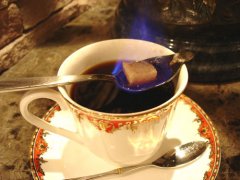Do Peruvian beans taste good? the planting and processing of Peruvian beans

For professional baristas, please follow the coffee workshop (Wechat official account cafe_style)
Peru's finest coffee is produced in Chanchmayo.
, Cusco (Cuzco)
, Norte and Puno. Most Peruvian coffee is grown under natural conditions, but it is also difficult to confirm the cultivation of all coffee trees. Coffee grown under natural conditions costs 10% more than others. Judging from poverty, farmers may not have the money to buy chemical fertilizers and pesticides, but it is really difficult to confirm all the coffee.
The quality of Peruvian coffee is comparable to that of any kind of coffee in Central or South America. The high quality coffee produced by Peru is shipped to Germany for blending and then to Japan and the United States, which also illustrates its high standard of quality.
Coffee is high-quality and balanced and can be used for mixed drinks.
Peru (Peru) is also a big coffee producer. Up to 98% of Peruvian coffee is grown in forest areas, and most producers are small farmers.
Peru Peru
Population: 30475000
Except for the main areas listed below, the output quality of a few other producing areas is low and does not reach the recognized level. Some people may argue that Peru can cope well with warming climate change and that there is a lot of land at high elevations that could be suitable for growing coffee in the future.
CAJAMARCA
The Cajamaca region is located in northern Peru, named after its capital, and covers the northern tip of the Peruvian Andes. The advantage of the region lies in the equatorial climate and the soil suitable for coffee cultivation. Although most producers are small farmers in their areas, they are often well organized and affiliated to the organization. The organization provides producers with technical assistance, training, loans, development and other support from all walks of life. One of the organizations, CENFROCAFE, operates in the area and has 1900 small farmers, promoting coffee roasting and local cafes to help farmers diversify.
Altitude: 900-2050m
Harvest: March-September
Variety: Typica,Caturra, bourbon, Panha Mengnuo, Catua
JUNIN
Hunin produces about 20%, 25% of Peruvian coffee, which is produced in the rainforest. The area suffered as a result of guerrilla activities in the 1980s and 1990s, during which neglect of trees spread plant diseases. In the late 1990s, the coffee industry started from scratch.
Altitude: 1400-1900m
Harvest: March-September
Varieties: bourbon, Typica,Caturra Pash, Menneau, Catuai
CUSCO
Cusco is located in southern Peru and in some ways coffee is a legal alternative to cocaine. Most
Coffee is grown by small farmers, not by large estates. Tourism is booming in the region, and many tourists pass through Cusco on their way to Machu Picchu.
Altitude: 1200-1900m
Harvest: March-September
Variety: bourbon, Typica,Caturra,Pache,Modo Novo,Catuai,Catimor
Peruvian coffee features:
The quality of Peruvian coffee is comparable to that of any kind of coffee in Central or South America.
Flavor: balanced taste and delicious acidity
Suggested roasting method: medium to deep roasting, can be made into high-quality mixed coffee suitable for various uses
★: general
Peruvian coffee market:
The private Peruvian Coffee exporters Association (ComeradeExportadoresdeCafedelPeru) has been established, which is committed to improving the quality of coffee. Its primary task is to set standards and eliminate inferior products, so as to create an atmosphere of quality supremacy. This positive move heralds a bright future for the coffee industry. Since then, rising prices have encouraged farmers to actively grow coffee rather than cocoa, the region's traditional cash crop.
The high quality coffee produced by Peru is shipped to Germany for blending and then to Japan and the United States, which also illustrates its high standard of quality.
Coffee producing areas in Peru:
Up to 98% of Peruvian coffee is grown in forest areas, and most producers are small farmers.
Peru's finest coffee is produced in Chanchmayo, Cuzco, Norte and Puno. Most Peruvian coffee is grown under natural conditions, but it is also difficult to confirm the cultivation of all coffee trees. Coffee grown under natural conditions costs 10% more than others. Judging from poverty, farmers may not have the money to buy chemical fertilizers and pesticides, but it is really difficult to confirm all the coffee.
Peru has good economic conditions and a stable political situation, thus ensuring the good quality of coffee. However, there are many local problems, in addition to guerrilla warfare and drug trafficking, the emergence of cholera along the coast in the mid-1990s led to a further economic depression, and what is more, the annual inflation rate reached 7000%.
In the mid-1970s, Peruvian coffee production was about 900000 bags a year, and then steadily increased to about 1.3 million bags a year. Although private exporters buy coffee in remote areas through middlemen, the main market is still monopolized by the government. Then came the private Comerade Exportadores de Cafe delPeru, which is committed to improving the quality of coffee. Its primary task is to set standards and eliminate inferior products, thus creating an atmosphere of quality supremacy. This positive move heralds a bright future for the coffee industry. Since then, rising prices have encouraged farmers to actively grow coffee rather than cocoa, the region's traditional cash crop.
Important Notice :
前街咖啡 FrontStreet Coffee has moved to new addredd:
FrontStreet Coffee Address: 315,Donghua East Road,GuangZhou
Tel:020 38364473
- Prev

How to deal with El Salvador single Bean how to divide the grades of El Salvador single Bean
Exchange of professional baristas Please pay attention to the reputation of the APANECA-ILAMATEPEC MOUNTAIN RANGE APANECA-ILAMATEPEC Mountains of the coffee workshop (Wechat official account cafe_style). With the coffee winning in many competitions, there is no doubt about the quality of the coffee. Although there is a lot of volcanic activity here, the most recent one was in 2005, when Santa Ana erupted and caffeinated it for several years.
- Next

Peruvian bean producing area introduces how to brew Peruvian single bean.
Exchange of professional baristas follow the coffee workshop (Wechat official account cafe_style) Peruvian coffee production: up to 98% of Peruvian coffee is grown in forest areas, most of the producers are small farmers. Peru's finest coffee is produced in Chanchmayo, Cuzco, Norte and Puno. Most Peruvian coffee is
Related
- Does Rose Summer choose Blue, Green or Red? Detailed explanation of Rose Summer Coffee plots and Classification in Panamanian Jade Manor
- What is the difference between the origin, producing area, processing plant, cooperative and manor of coffee beans?
- How fine does the espresso powder fit? how to grind the espresso?
- Sca coffee roasting degree color card coffee roasting degree 8 roasting color values what do you mean?
- The practice of lattes: how to make lattes at home
- Introduction to Indonesian Fine Coffee beans-- Java Coffee producing area of Indonesian Arabica Coffee
- How much will the flavor of light and medium roasted rose summer be expressed? What baking level is rose summer suitable for?
- Introduction to the characteristics of washing, sun-drying or wet-planing coffee commonly used in Mantenin, Indonesia
- Price characteristics of Arabica Coffee Bean Starbucks introduction to Manning Coffee Bean Taste producing area Variety Manor
- What is the authentic Yega flavor? What are the flavor characteristics of the really excellent Yejasuffi coffee beans?

